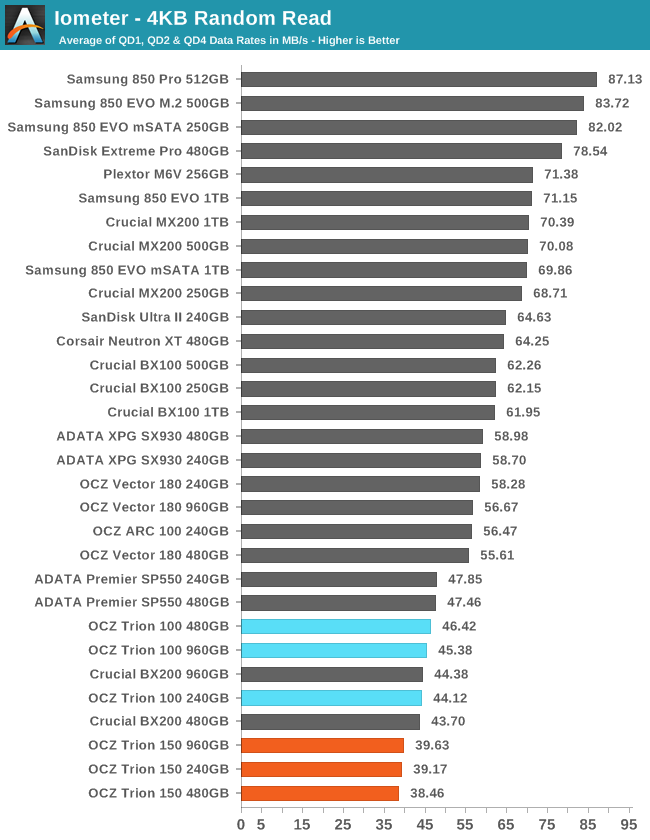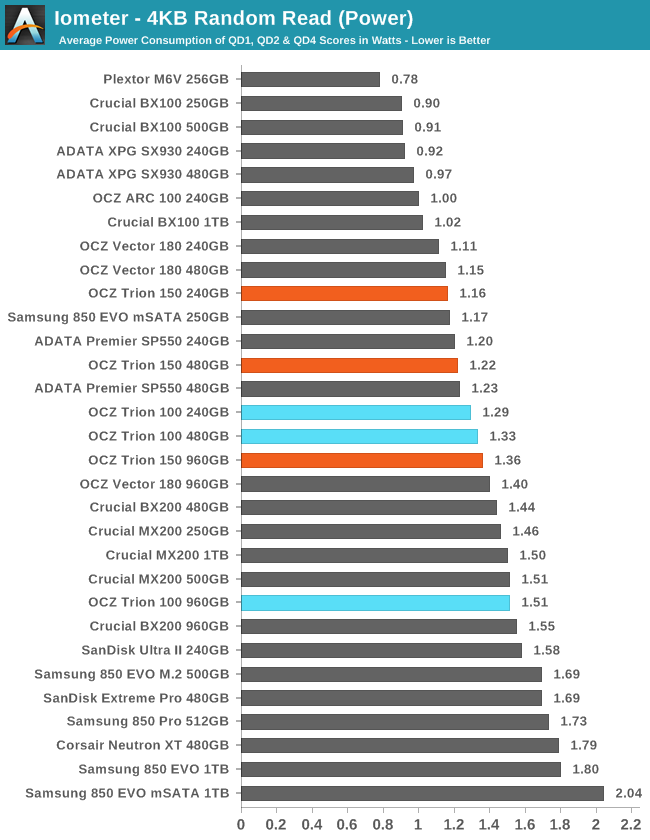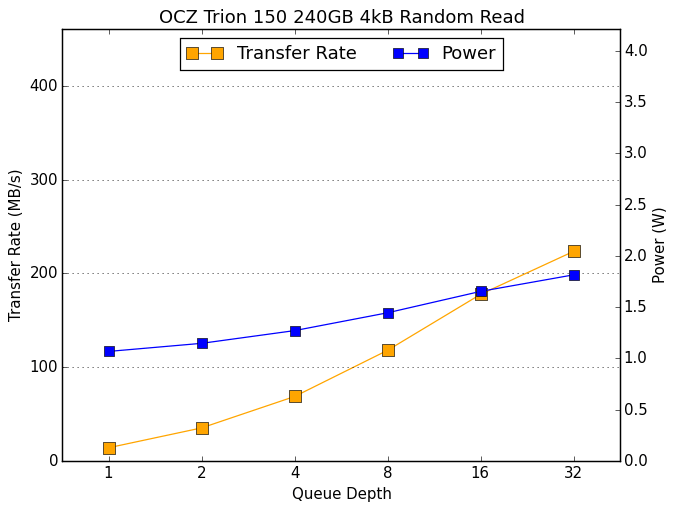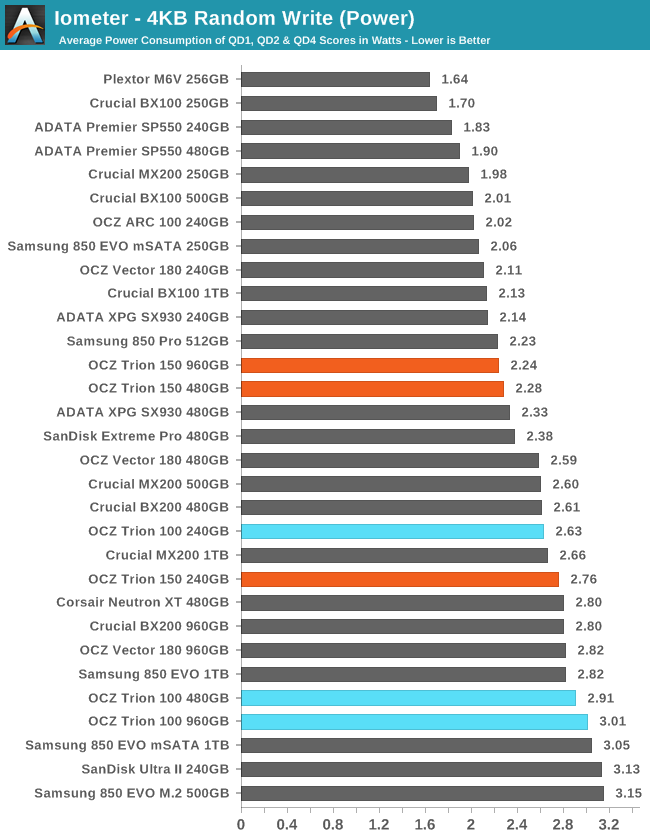The OCZ Trion 150 SSD Review
by Billy Tallis on April 1, 2016 8:00 AM ESTRandom Read Performance
The random read test requests 4kB blocks and tests queue depths ranging from 1 to 32. The queue depth is doubled every three minutes, for a total test duration of 18 minutes. The test spans the entire drive, which is filled before the test starts. The primary score we report is an average of performances at queue depths 1, 2 and 4, as client usage typically consists mostly of low queue depth operations.

The Trion 150 sets a new low for small queue depth random read speeds, with half the performance of the best SATA drives. This is probably the primary cause of the poorer latency scores seen on the ATSB tests. For context, the QD1 performance of the 480GB Trion 150 is still almost 50 times faster than a 7200RPM hard drive.

Power consumption has at least decreased in kind with the reduced performance, but the ADATA SP550 manages slightly better efficiency than the Trion 150 and most MLC drives are much more efficient.
 |
|||||||||
The 480GB Trion 150 doesn't perform quite as well at the highest queue depths as the other capacities, but all sizes perform considerably worse than the competition, especially at high queue depths.
Random Write Performance
The random write test writes 4kB blocks and tests queue depths ranging from 1 to 32. The queue depth is doubled every three minutes, for a total test duration of 18 minutes. The test is limited to a 16GB portion of the drive, and the drive is empty save for the 16GB test file. The primary score we report is an average of performances at queue depths 1, 2 and 4, as client usage typically consists mostly of low queue depth operations.

Random write speed on the 240GB Trion 150 got a huge boost over the Trion 100 and even the larger Trion 150s, but they all improved and widened the lead over SM2256 drives.

Power efficiency during random writes is much improved. The 240GB Trion 150 draws slightly more power than the 240GB Trion 100, but that's completely justified by the performance jump.
 |
|||||||||
The queue depth scaling behavior is quite odd. The 240GB Trion 150 doesn't change past QD4, but the larger sizes see a huge improvement moving to QD8 and beyond. This can make for some nice benchmark numbers but won't have much real-world impact. At low queue depths the 240GB comes out well ahead. This discrepancy is most likely a difference in the SLC caching configuration between the different models. Whatever the cause, the 240GB drive is making the better choices.










79 Comments
View All Comments
ocztaec - Tuesday, April 5, 2016 - link
Hi Arnulf,As this is my first post on this article please allow me to identify myself as a Toshiba America Electronic Components (TAEC) representative. We completely understand the quality concerns and appreciate your comments. Since the Toshiba acquisition of OCZ in 2014 improving product reliability is a key priority for us. We made significant changes to everything from processes to production. OCZ SSDs are made with premium Toshiba NAND and is back by the Advanced Warranty Program.
We understand how you feel and hope that one day we will have the opportunity to demonstrate the reliability of current OCZ products. Thank you again for your feedback.
nathanddrews - Friday, April 1, 2016 - link
Not a great showing, that's for sure. I'd like to point out two things - one is that we're looking at a range of drives that could be offering 2TB SSDs for under $400. WhereTF are they? I feel like we've been pretty patient, but at these prices, I can actually afford to replace all disks on my PCs and getting really close to replacing disks on my servers and NAS units.Second, would it be at all reasonable to add a WD VelociRaptor, Hybrid SSHD, and/or common 5400RPM hard drive to the 2015 SSD Bench like the old days? I think most of the readership knows how much better ANY SSD is over a mechanical HDD, but I think we also get a bit too cynical with drives like this that are "slow" compared to other SSDs and won't even consider buying them. We shouldn't forget where we came from. XD
tarqsharq - Friday, April 1, 2016 - link
I second this, really want to keep perspective on speeds, especially when we're dealing with the low cost SSDs where you can get high storage space for low $$ImSpartacus - Saturday, April 2, 2016 - link
Yeah, it would a fantastic way to gain context. Just don't worry about scaling the graphs for the hard drives if that ever becomes an issue.bug77 - Friday, April 1, 2016 - link
Have you seen the size increase of the PCB? There's no space for 2TB worth of chips.DanNeely - Friday, April 1, 2016 - link
Agreed, as stated in the 2nd paragraph of the article: "It's important to keep in mind that for the cheapest SSDs on the market, maximizing performance is not the only goal and often isn't even a primary goal." Yes, the performance sucks compared to anything the average Anandtech reader would put in his computer, but these drives are intended to get people who buy cheap crappy computers at the boxmark off of spinning rust. It might help if the performance charts were split between performance and budget SSDs, otherwise is as unfair as comparing a standard HDD to a 15k SAS drive would've been a dozen years ago.It's still probably 2 or 3 generations before I'd consider SSDing my NAS. Pricing even on cheap SSDs is still ~6x that of NAS HDDs; it'd need to drop to at most 2x before I'd consider it; at that point reduced power consumption over a half dozen years might be able to close enough of the gap that quieter operation and smaller size might be worth the larger up front cost. Also, I'd want at least 6gb of post RAID storage capacity if standing up a new NAS today; probably 10 or 12 if I'd be filling all the bays and unable to add more storage to it later; with my needs growing by about 2x every 3-4 years. The smaller criteria could be met by 4x2gb drives in raid 5; the latter would either need 4gb drives or an 8 bay enclosure. Pre-built 8-bay NASes suffer from an additional enterprise price premium; while on the DIY front that many sata ports is stretching what can be done with cheap hardware and I'm not aware of any mITX sized cases with that many drive bays.
bji - Friday, April 1, 2016 - link
Just curious, what do you do with all that storage? 10 to 12 TB (I assume your 6gb was a typo and you meant 6tb) is a hell of alot of storage. What do you need so much storage for?I am still using a first gen Macbook pro retina with 256 GB of SSD storage and I have 90 GB free. Even my server that does backups and stuff uses only about 350 GB.
DanNeely - Friday, April 1, 2016 - link
Media and system backups. About half of the latter is images of old systems that I got rid of at some point. Feeding bigger drives into the nas is a lot easier than trying to scour a system to make sure everything of value's been removed separately. Most recently some scanned documents a family member left in the scanner apps temp folder (that I didn't even know existed).bji - Friday, April 1, 2016 - link
What kind of media needs that much storage? Are you a professional videographer?Arnulf - Saturday, April 2, 2016 - link
P0rn :)